Research Notes on Mourning from Ackermann's Repository of Arts
Hope Greenberg
Royal deaths:
Princess Charlotte (George IV’s daughter) 6 November 1817
Queen Charlotte (George III wife), 17 November 1818
Edward, Duke of Kent (son of George III, father of Queen Victoria) 23
January 1820
George III, 29 January 1820 (George IV's coronation was 19 July 1821)
Princess Frederica Charlotte of Prussia (wife of Frederick, Duke of York,
second son of George III) 6 August 1820
Caroline of Brunswick, (George IV wife) 7 August 1821
[Note: It was typical for the King or Prince to formally shorten the period of mourning in a "humane consideration for the numerous body of tradespeople whom a long continuance of deep mourning would be the means of seriously injuring." Also, note the mentions of white mixed with black and even coloured ribbons with black for even deep mourning.]
1817, December (mourning Princess Charlotte)
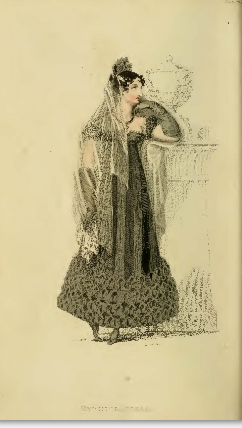
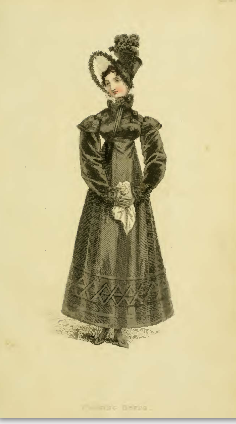
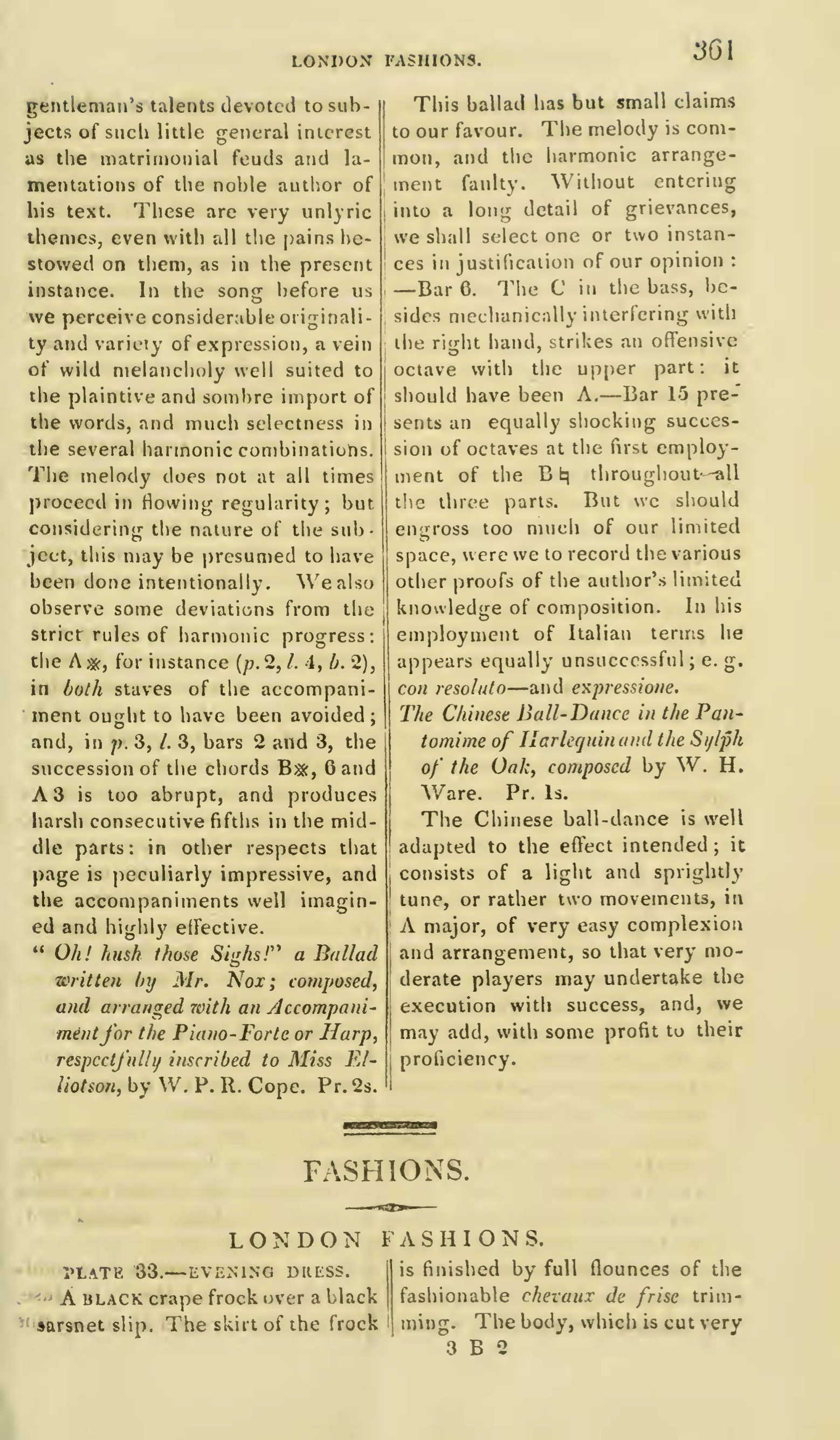 [PDF]
[PDF]
1) Evening Dress
A black crape frock over a black sarsnet slip….
2) Walking Dress
A high dress composed of bombazeen; the bottom of the
skirt is ornamented with black crape…[NB: bombazeen, or bombasine, was a twill-weave heavy silk with a dull, non-reflective surface.
And in “General Observations on Fashion in Dress”: (p. 362-363)
A short period only has elapsed since we had the pleasure of recording
in this department of our Magazine, the gay changes which the marriage of
our adored Princess had made in the world of Fashion. How little did we then
anticipate the melancholy task at present assigned to us, of describing the
mourning worn for her by a country who looked up to her as its future ruler,
and who witnessed with delight the gradual development of those virtues
which proved her the true descendant of her venerable grandfather. ..
The court mourning consists as usual, of crape, bombazeen, and lawn;
and such is the general wish to show every possible respect to the memory of
our lamented Princess, that the materials for court mourning are generally
adopted by all persons of fashion, whether connected with the court or not…
Bombazine frocks appear to be universally adopted in dinner dress. They are
always cut very low around the bust, and are very short in the waist…The
bodies of dresses are now more becomingly made than they were some time
back, as the sleeve just touches the point of the shoulder…
The full dress which we have given in our print is the most elegant novelty
that has appeared in evening costume. We have since seen at one of our most
fashionable milliners, evening dresses composed of black crape, which were
full trimmed with white crape. This is not inconsistent with the deepest
mourning, and these dresses are peculiarly calculated for very young ladies;
though they are equally adopted, as we understand, by those of middle age.”
[The response in fashions from France, where court mourning, to the surprise
of many, was declared as 6 days of deep mourning and 5 of slight, is also
described in the “French Female Fashions” section. It concludes with “Next
month I shall endeavor to describe to you the dresses considered most
fashionable; because, although I suppose your mourning in England will be at
least of three months’ duration, yet you may perhaps have some things which
I shall describe to you made up in black.”]
1818, January
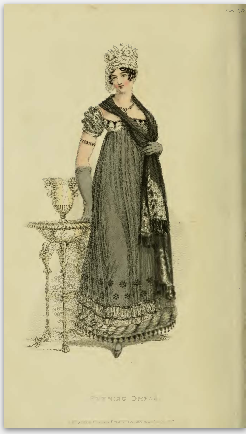
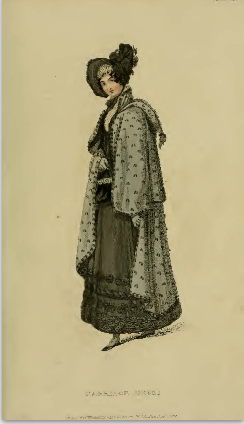
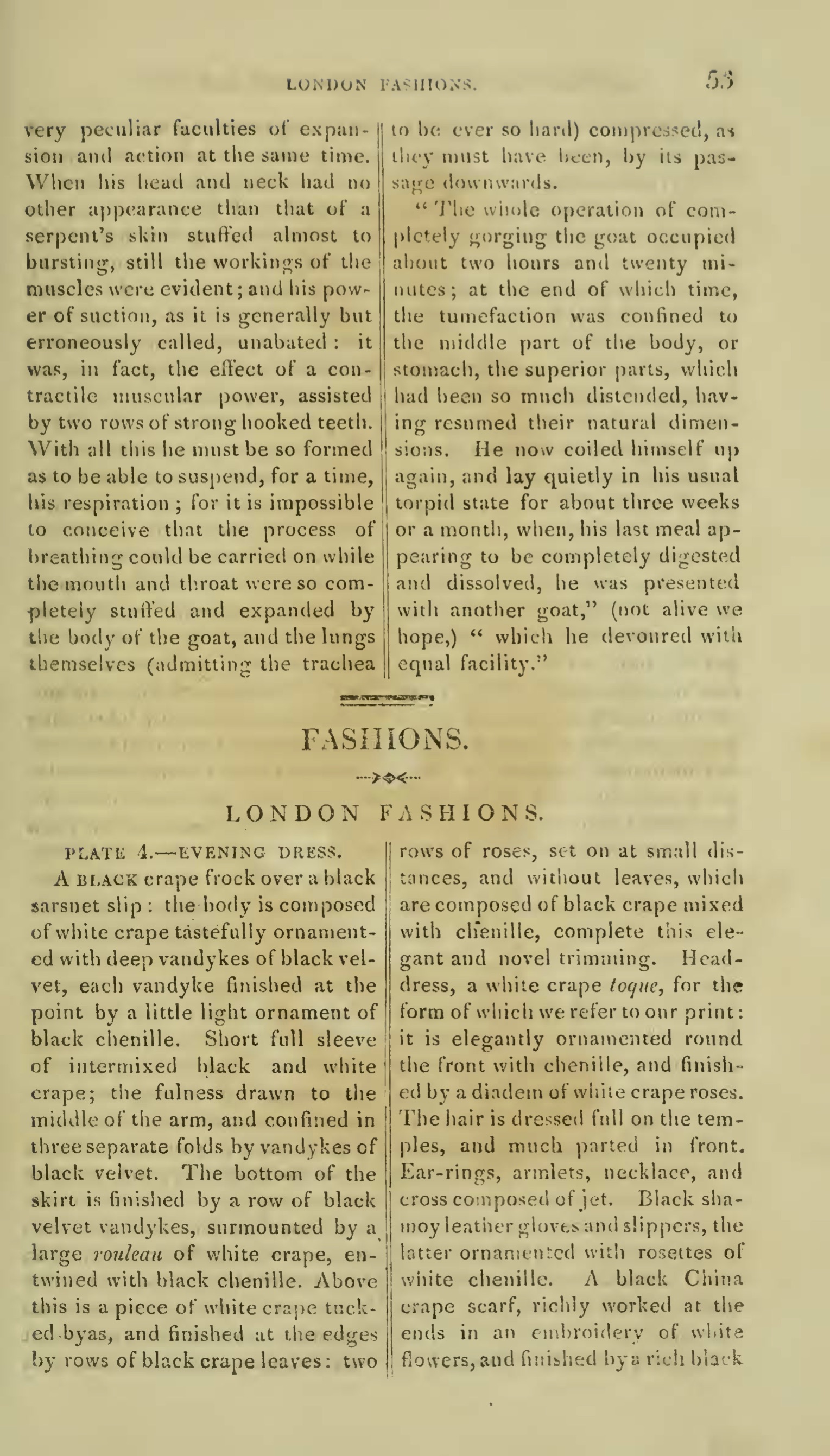 [PDF]
[PDF]
1) Evening Dress
Black crape frock over a black sarsnet slip: the body is
composed of what crape tastefully ornamented with deep vandykes of black
velvet…[worn with a white crape toque]
2) Carriage dress
“Bombazine high dress: the body which is made quite plain,
fastens behind. There is no collar but it is full tried round the throat
with black crape…With this dress is worn the Russian wrapping-cloak,
composed of tufted mole-skin cloth, and lined with black sarsnet…”
And in “General Observations of Fashion and Dress”:
“The mourning garb of our fair notaries of Fashion has experienced little
alteration since the publication of our last number…
Black bombasine is universally worn for dinner dress, and is also adopted
for social evening parties.”
The bodies of other dresses are made partially high round the back of the
neck; the back is plain, and buttons up behind with small jet buttons; the
front has a little fullness at each side of the shoulder-step; the middle of
the bust is plain…Plain long sleeves…We recommend this dress, at least the
manner in which the body part is made, to those of our subscribers who are
of the middle age; it is at once delicate and becoming. We understand that
several matronly ladies of distinction have given orders for dresses made in
this style, and we shall be glad to see it generally adopted.
Black crape over black sarsnet is universally adopted for full dress…
We understand that it is expected, dresses both of bombasine and black
crape, trimmed with white crape, will be worn, particularly by young ladies.
We consider this as very likely, because it is still very deep mourning,
though less gloomy than all black: we have not yet, however, seen any of
them.
Several trimmings, composed of black crape and intermixed with scarlet, are
we understand in preparation for some very dashing elegant. This mixture of
black and scarlet has of late years been tolerated even in the deepest
mourning; in our opinion if is far from appropriateand we believe it is now
likely to be confined to those ladies whom the French would style
merveilleuses…
It is almost superfluous to mention, that all ornaments for the hair etc. at
present are composed of jet. Gloves and shoes are always of black shames
leather.”
1818, December (mourning Queen Charlotte)
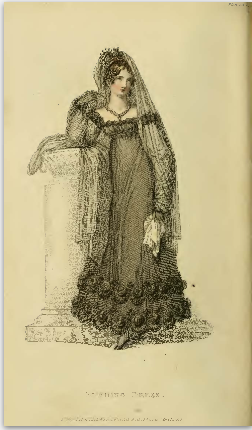
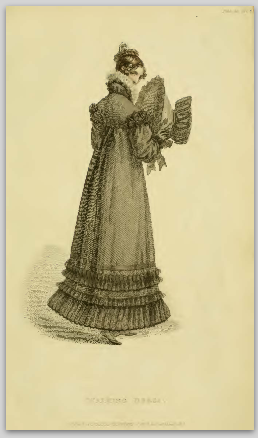
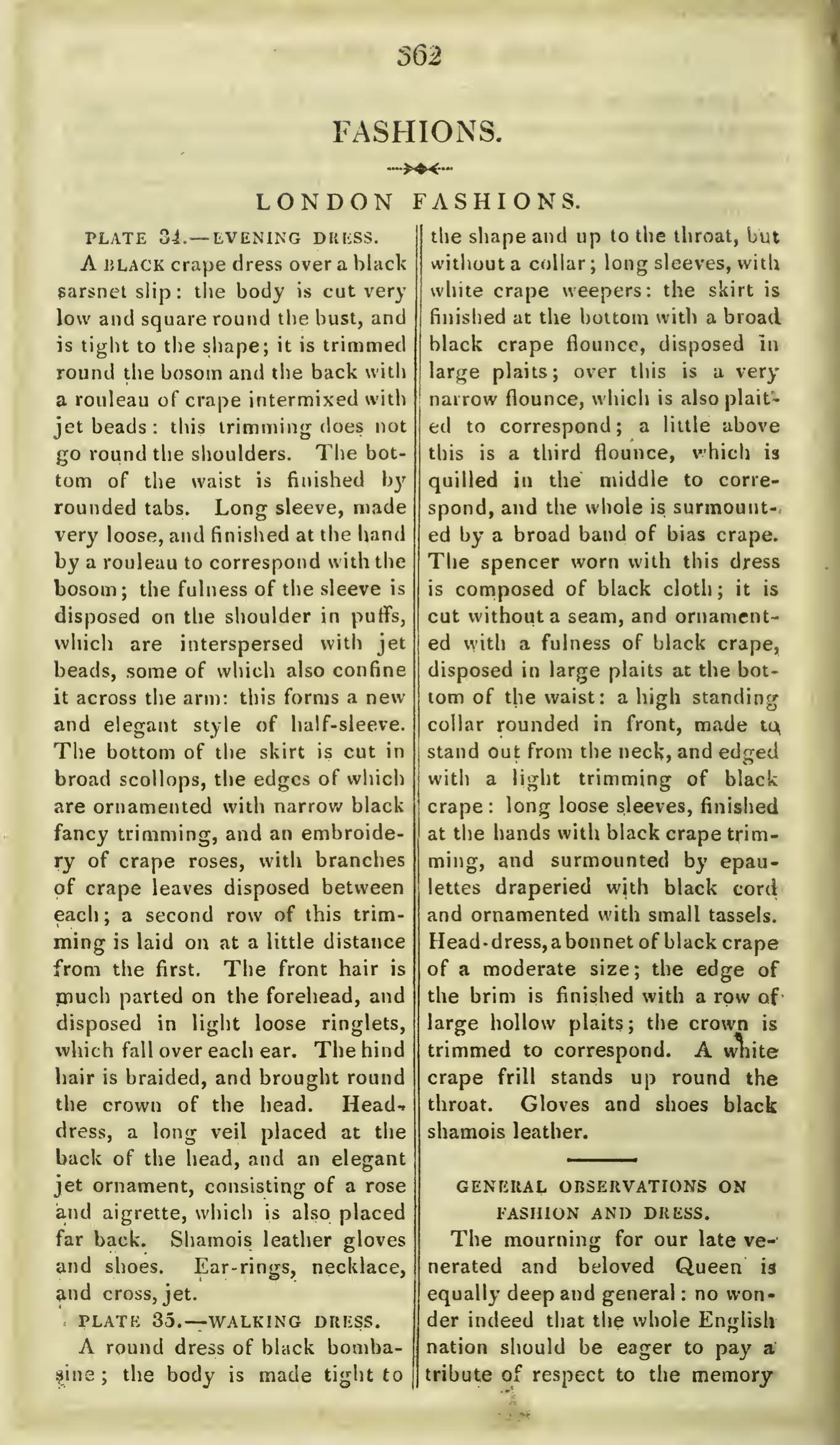
1) Evening Dress
A black crape dress over a black sarsnet slip: the body is cut very low and
square round the bust, and is tight to the shape…Long sleeve, made very
loose, and finished at the hand by a rouleau to correspond…
2) Walking Dress
A round dress of black bombasine; the body is made tight to the shape and up
to the throat but without a collar…
And in “General Observations of Fashion and Dress”:
“The mourning for our late venerated and beloved Queen [Charlotte, George III
wife] is equally deep and general: no wonder indeed that the whole English
nation should be eager to pay a tribute of respect to the memory of a
sovereign, whose truly feminine virtues added lustre to her exalted rank.
The lord chamberlain’s orders for court mourning are, black bombasine,
crape, long lawn, and plain muslin for dress; and dark Norwich crape for
undress.”
1819, January, Half-Mourning (Queen Charlotte)
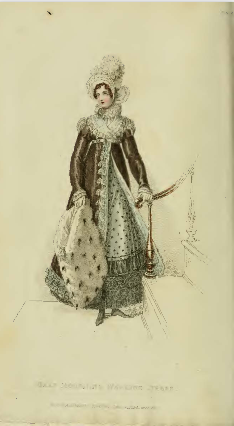
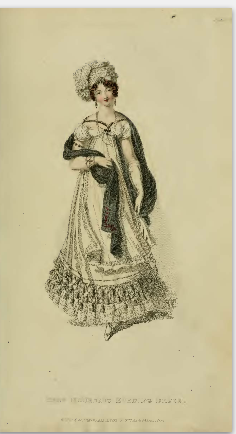
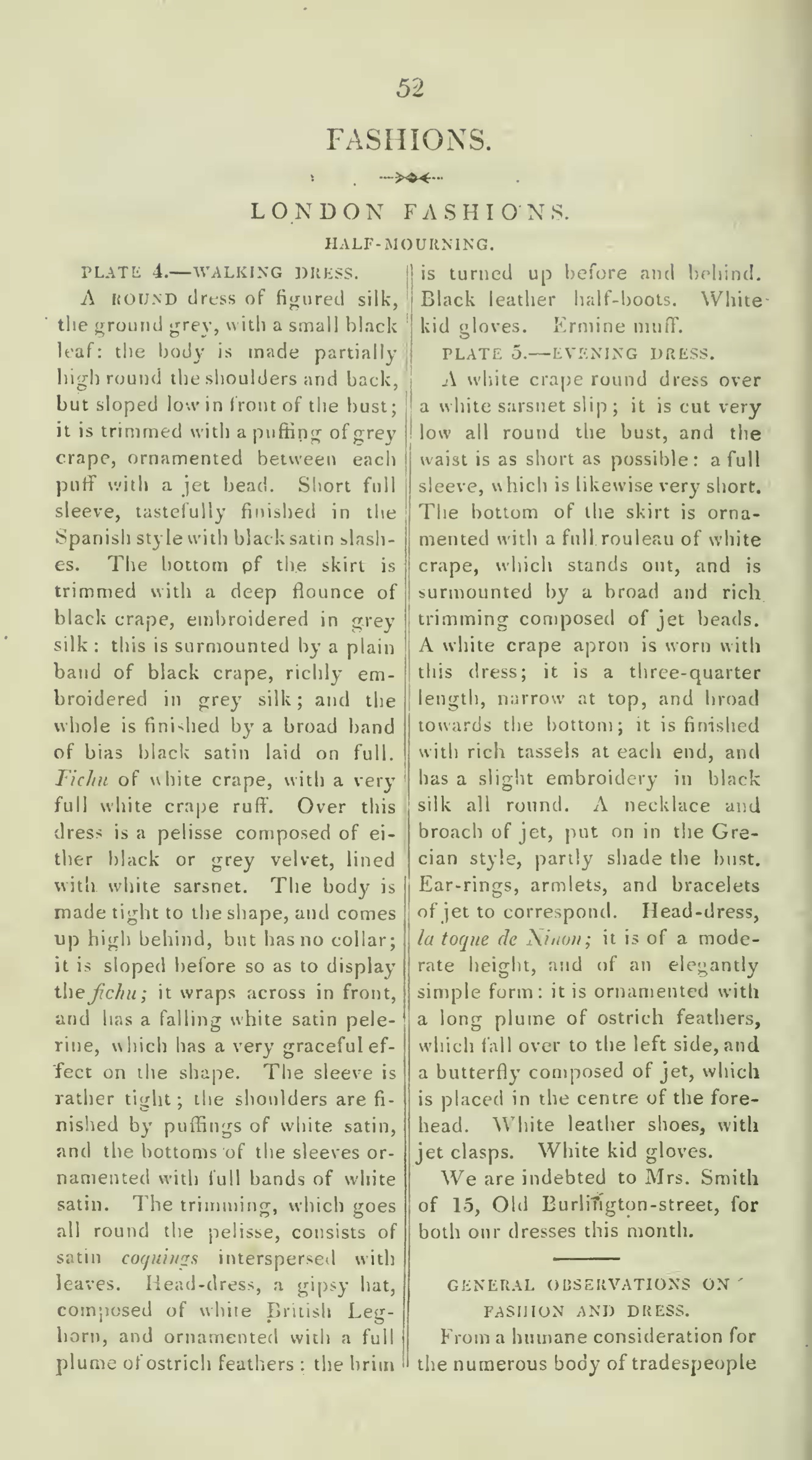
1) Walking Dress
A round dress of figured silk the ground grey, with a small black leaf…Over
this dress is a pelisse composed of either black or grey velvet…
2) Evening Dress
A white crape round dress over a white sarsnet slip…black silk embroider all
around…trimmed with jet
And in “General Observations of Fashion and Dress”:
“From a humane consideration for the numerous body of tradespeople whom a
long continuance of deep mourning would be the means of seriously injuring,
His Royal Highness the Prince Regent has graciously ordered a change of
mourning in the beginning of this month. The mourning for the court consists
of black silk with plain muslin; and on the 24th black silk with colored
ribbons. We must observe, however, that this etiquette seems likely to be
confined to the court, as the mixture of black and white in full dress, and
black and grey in undress, is expected to be very general in the highest
circles…
Grey or white lutstrings, poplins, and tablets, are in preparation for
undress: the trimmings are crape…
This is the most lady-like slight mourning that we have seen; we say slight,
because black sarsnet can never be considered deep mourning…
Black shoes, or half-boots, and white gloves for morning; and white gloves
and shoes for evening: the latter have always black rosettes or clasps.”
1820, February (mourning HRH Duke of Kent)
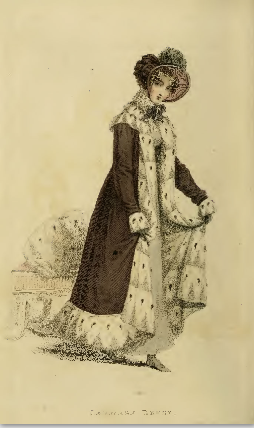
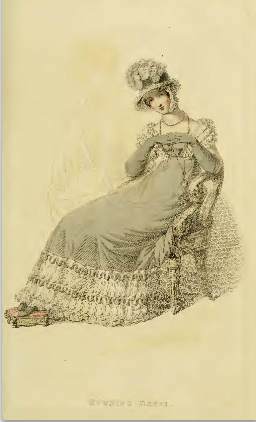
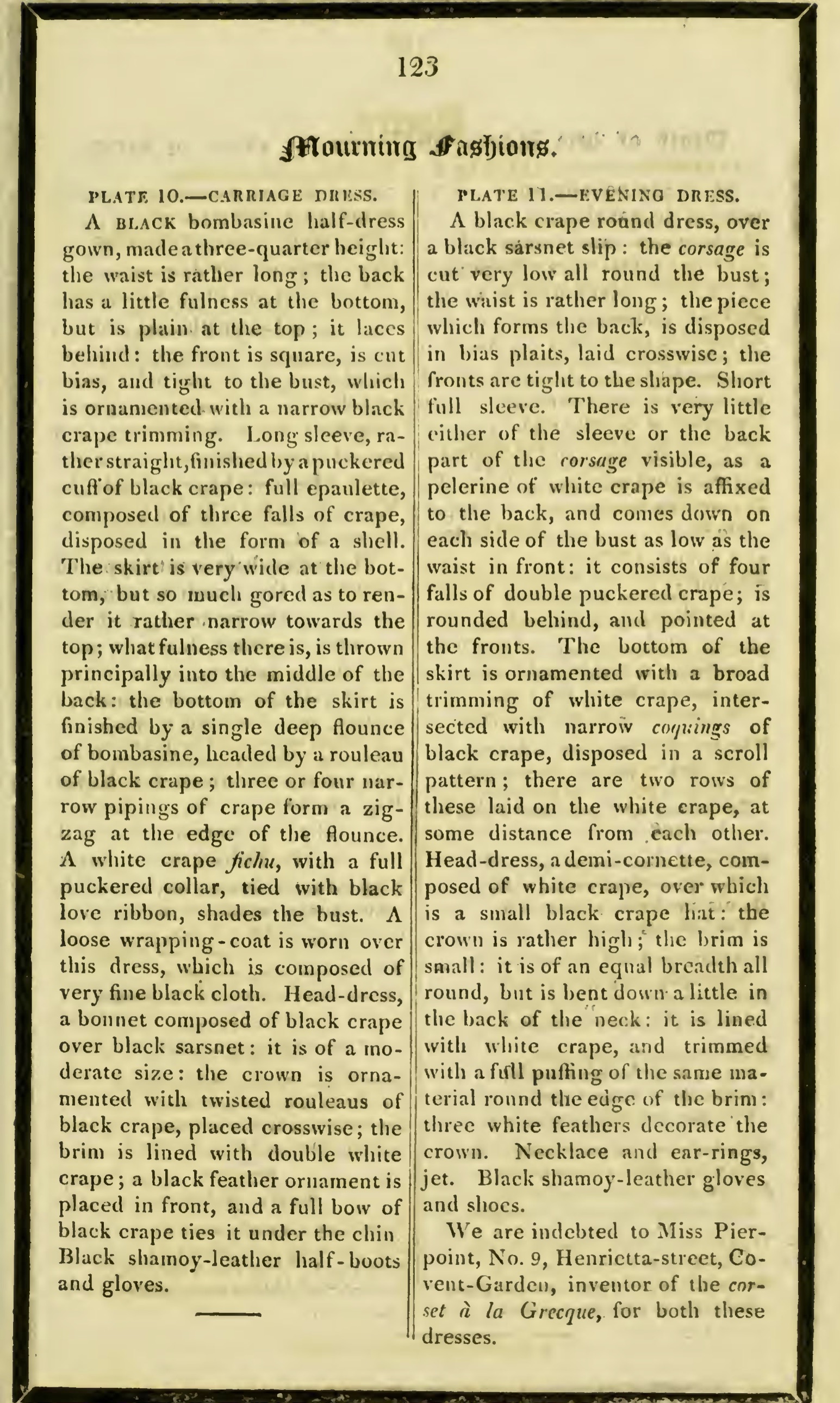
Mourning Fashions (printed with black border)
1) Carriage Dress
A black bombasine half-dress gown, made a three-quarter height…a loose
wrapping-coat is worn over this dress, which is composed of very fine black
cloth.
2) Evening Dress
A black crape round dress, over a black sarsnet slip
1820, March (mourning George III)
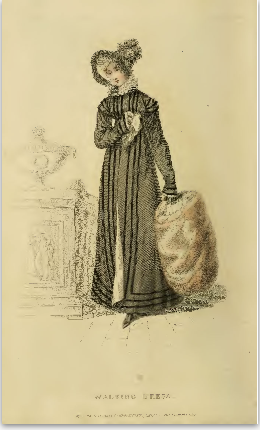
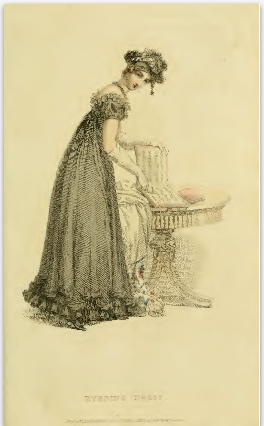
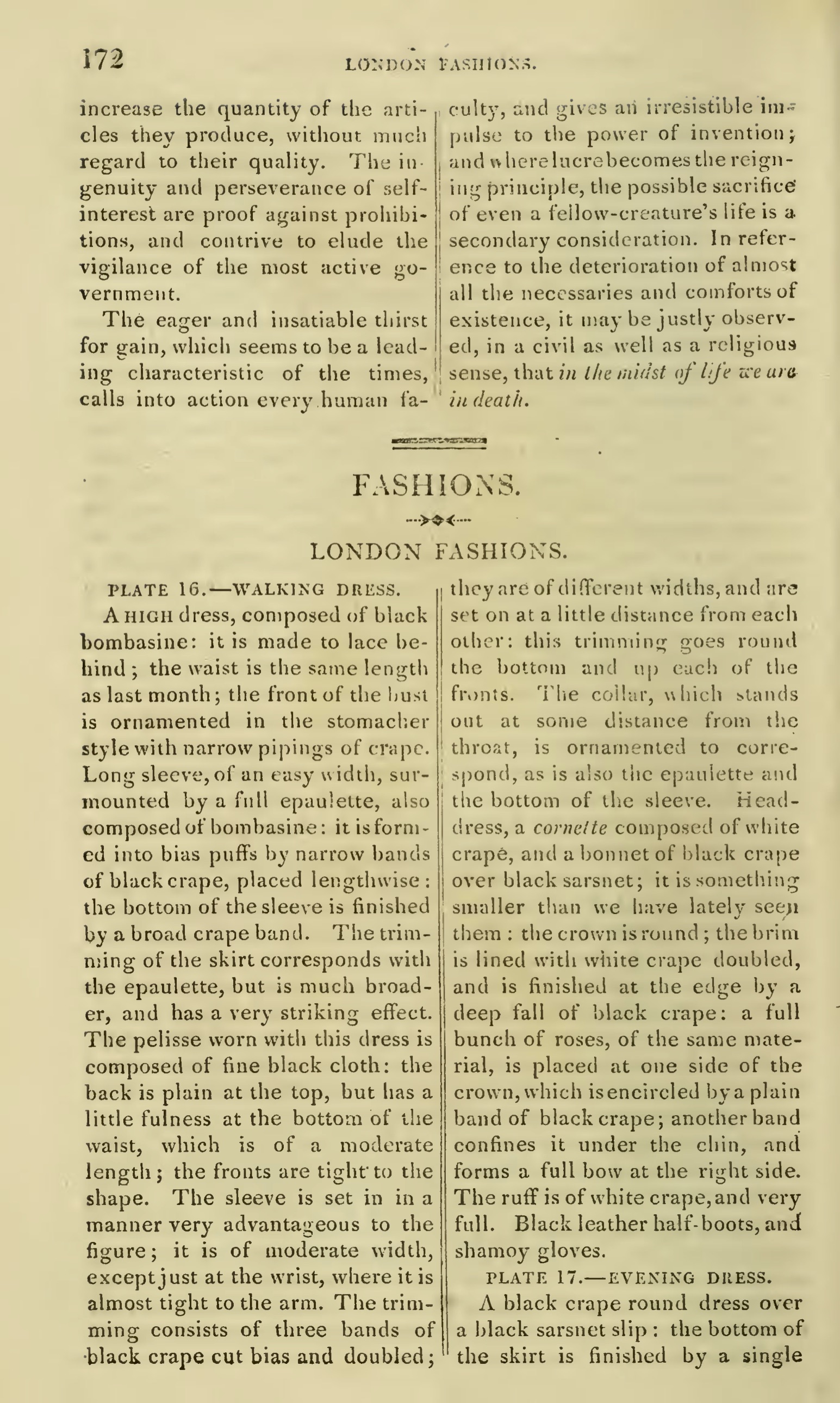 [PDF]
[PDF]
1) Walking Dress
A high dress, composed of black bombasine…the pelisse worn over this dress
is made of fine black cloth.
2) Evening Dress
A black crape round dress over a black sarsnet slip…
And in “General Observations of Fashion and Dress”:
The sombre hue which this department of our work assumed last month, in
consequence of the death of a Prince universally and deservedly beloved and
regretted, is destined to be continued on an occasion even still more
melancholy: our excellent and venerable Sovereign, the true father of his
people, to whom, for a period of nearly sixty years, we have looked up as
the model of private and public virtue, is taken from us….
…we observe with surprise and regret, that the mourning is by no means of
that deep and appropriate description which the occasion calls for. The lord
chamberlain’s orders are in very few instances strictly attended to: black
poplins, velvets, and silks of various descriptions, none of which can with
propriety be called mourning, being as much, or more, worn, than black crape
or bombasine. Norwich crape, the proper material for undress, is not used at
all.
1820, April
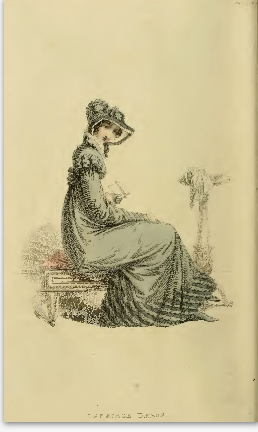
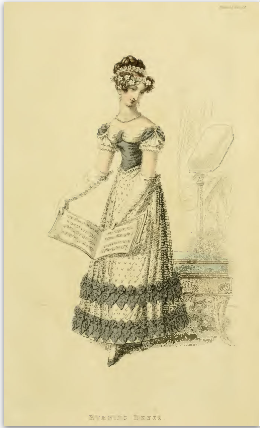
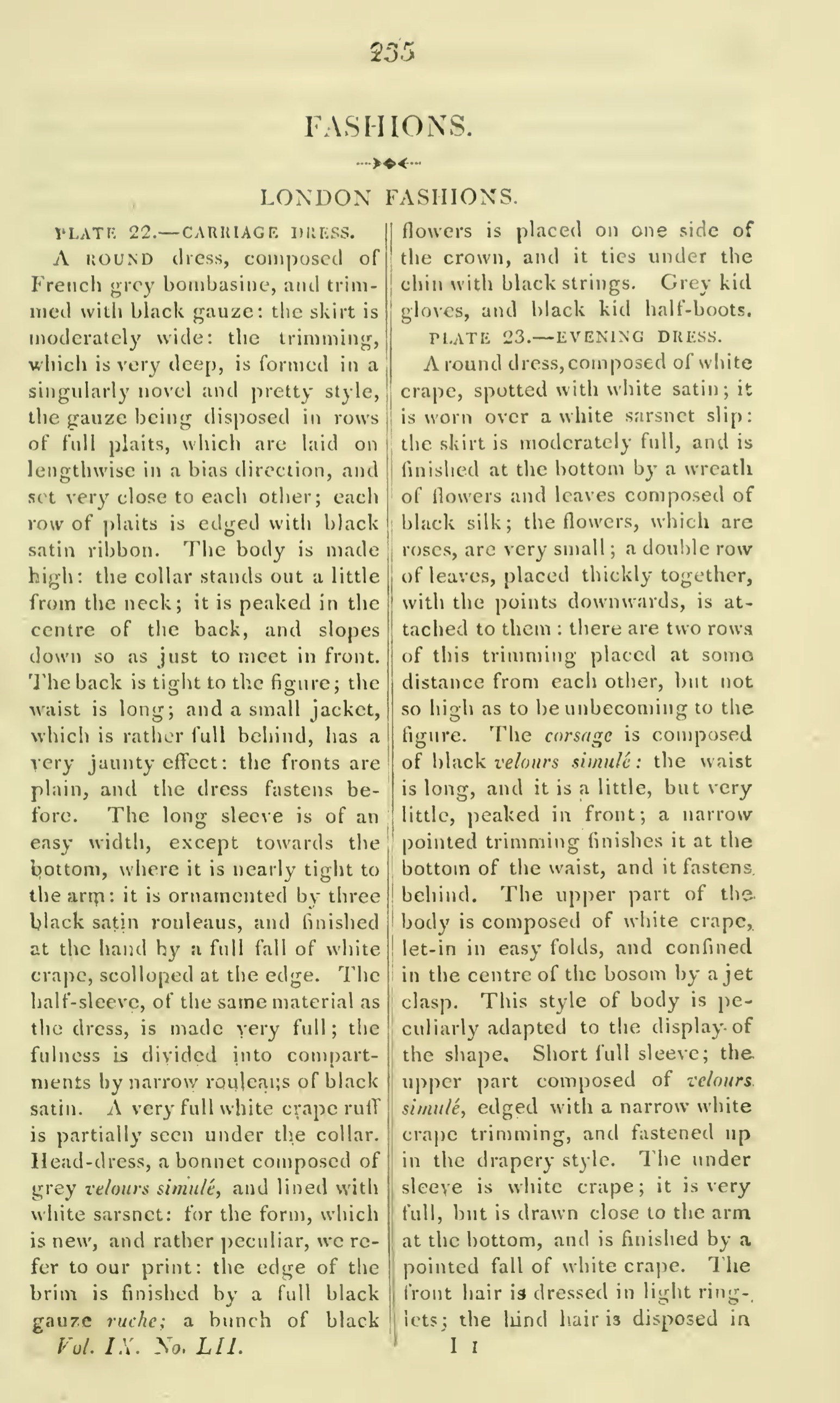 [PDF]
[PDF]
1) Carriage Dress
A round dress, composed of French grey bombasine, and trimmed with black
gauze
2) Evening Dress
A round dress, composed of white crape, spotted with white satin, it is worn
over a white sarsnet slip: the skirt is moderately full, and is finished at
the bottom by a wreath of flowers and leaves composed of black silk.
And in “General Observations of Fashion and Dress”:
“His Majesty has been graciously pleased, in consideration of the interests
of trade, to shorten the period of mourning for his late venerable and
lamented father…The first change for the courst is from bombasine and crape,
to plain black silk; the undress, French grey bombasine: the next change is
to be plain black silk, with colored ribbons or flowers; and it is expected,
that white with black ornaments will likewise be worn…
The Lord Chamberlin’s orders must, of course, be complied with by those
immediately about the court; but it is supposed, that black silk, with
colored flowers and ribbons, will not be worn out of that circle. On the
contrary, there is good reason to believe, that we shall adopt the fashion
prevalent in France, of white dresses with black ornaments. …we have given
one of the most elegant of these in our print.”
1820, September (mourning Princess Frederica Charlotte)
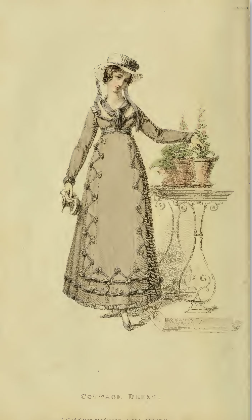
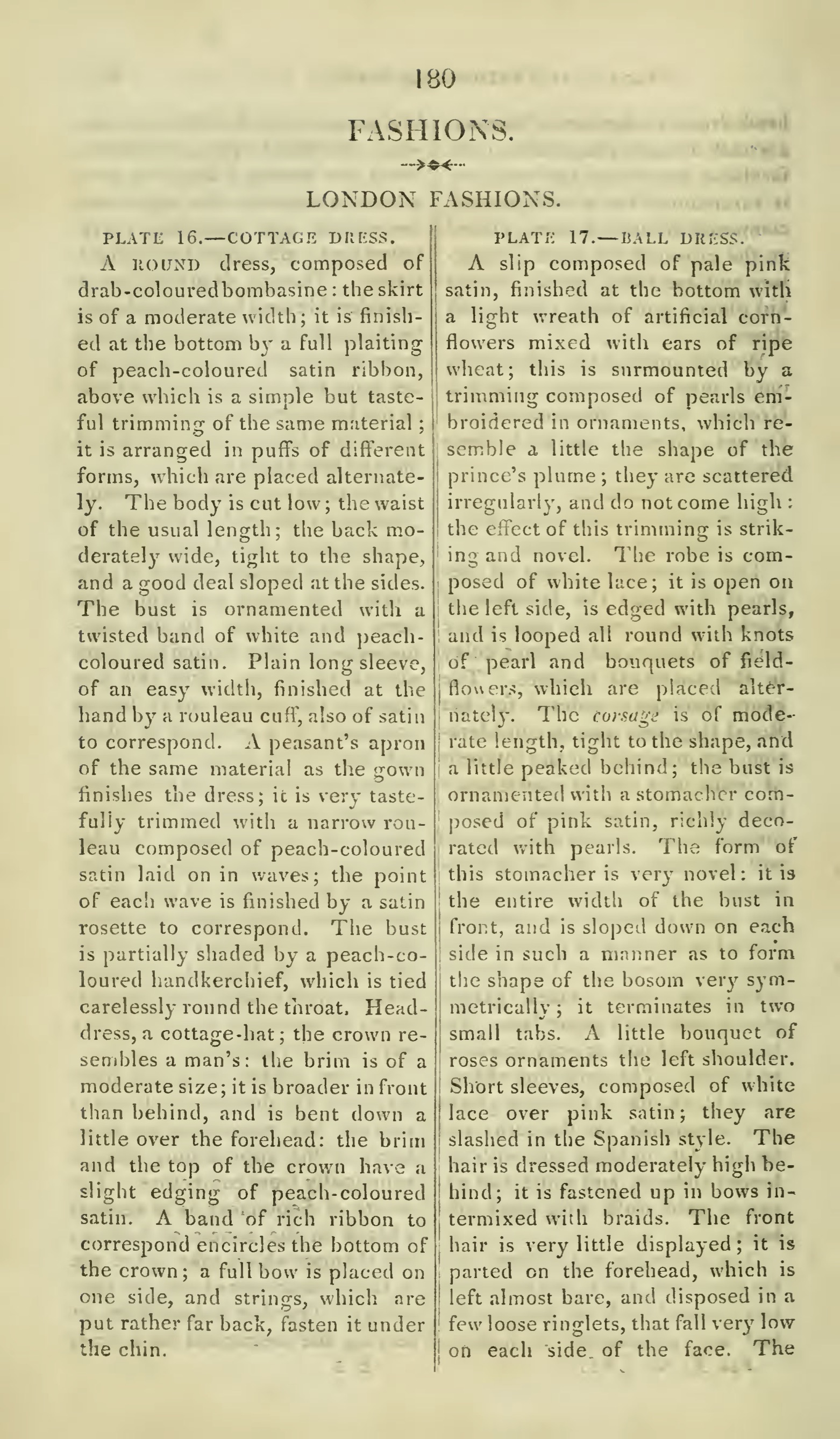
1) Cottage Dress
A round dress of drab-colored bombasine: the skirt is of moderate width; it
is finished at the the bottom by a full plaiting of peach-colored satin
ribbon…
And in “General Observations of Fashion and Dress”:
“The melancholy event of her Royal Highness the Duchess of York’s death,
which took place early in August, has caused a delay in the autumnal
fashions. The court mourning ordered for her Royal Highness was, in
consideration, we presume, for the interests of trade, of a shorter
continuance that the public expected…
The mourning was ordered only for the court, but it was nevertheless general
with all persons who had any pretensions to fashion.
The mourning has been distinguished in general by the display of more taste,
than the sombre, livery of woe usually admits of; the mixture of black and
white has been very general.”
1821, September (Queen Caroline, George IV wife)
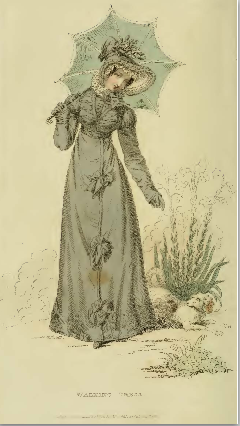
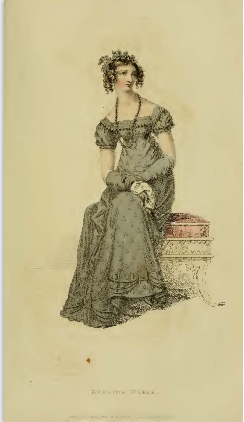
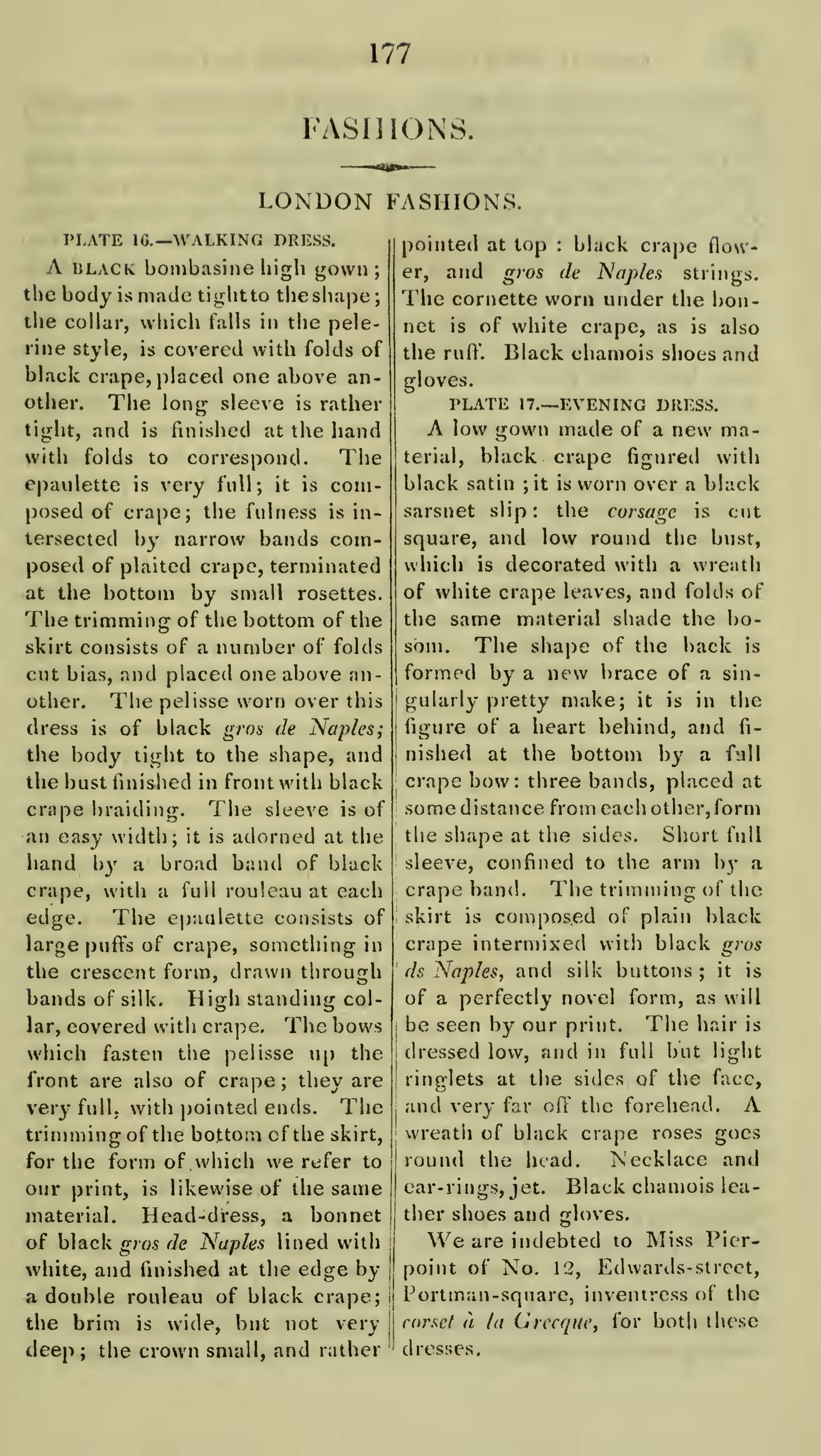
1) Walking Dress
A black bombasine high gown; the body is made tight to the shape…The pelisse
which is worn over this is of black gros de Naples…
2) Evening Dress
A low gown made of a new material, black crape figured with black satin; it
is worn over a black sarsnet slip: the corsage is cut square, and low round
the bust, which is decorated with a wreath of white crape leaves…
And in “General Observations of Fashion and Dress”:
“The melancholy event of her Majesty’s death has obliged our fair
fashionables to exchange the light and gay garb of summer for mourning
dresses. The orders of the Lord Chamberlain for court mourning are the same
as usual: black bombasine, crape, long lawn, and plain muslin for dress; but
owing to the introduction within the last few years of black silk into
mourning, we find that bombasine is less worn on the present occasion that
sarsnet, lutestring, and gros de Naples.”
Black as a non-mourning fashion color?
In addition to the full descriptions of each fashion plate, each month's Ackermann's contained articles describing the prevailing fashion. In this range of years these included one titled "General Observations on Fashion and Dress" and another, purported to be a recent letter from France, titled “French
Female Fashions.” In 1821 the French Female Fashions correspondent begins to refer to a "singular" (that soon becomes commonplace) occurence.
1821, March (French Female Fashions)
Rose and white are the two colors most in estimation; blue and ponceau are also in request; and what will appear to you very singular, black is much worn even for ball dresses: sometimes it is trimmed with rose colour, but in many instances the trimming is also black. I was lately at a ball where a lady who is noted for being the first to introduce singular fashions, appeared in a black tulle robe over a black satin slip; the corsage was a mixture of black velvet and satin ornamented with jet, the bottom of the robe was trimmed with black satin ribbon twisted in a corkscrew roll, and laid on in a wave; between each wave was a rosette composed of black satin intermixed with jet beads. Out of above one hundred ladies who were present, there were fourteen with black robes, and twelve with black slips, over which they had either white or colored gauze or crepe dresses. I was not a little pleased to see that not one of our countrywomen adopted this style of dress, so unsuitable to a festive scene.
1821, April (French Female Fashions)
We have not yet lost our fondness for black dresses, but they are less generally adopted, and I hope will soon be out of favour.
1821, May (French Female Fashions)
…[mentions black lace fichus]…
Let us now speak of grand costume. We have again resumed our fondness for les robes noir: at a ball where I was a few days ago, I saw several; but as they were all trimmed with colours, and many worn over white sating slips, they had not so very sombre and appearance; though I still regard the colour as most unsuitable to the festivities of a ball-room. One of the prettiest of these dresses was composed of soft black crape, and trimmed with a very full bouffant of black net, it was looped from distance to distance by a Provence rose with silver foliage...
1821, September (French Female Fashions)
Black gowns, though not now generally adopted in full dress, are still fashionable: they are composed always of black crape, and are worn over black silk slips. The most novel kind of crape is that figured with black satin leaves: these gowns are generally trimmed with black gauze ruches…
1821, December
“Black is still much in favor in full dress, particularly for public places:
these gowns are made either of silk or crape, but in general the sleeves are
of white satin or gauze. In order to shew that they are not in mourning, our
elegantes usually throw a Bayadere scarf, wither of orange, light blue, or
pence, loosely over their shoulders: these colors contrast very well with
the black, and contribute to enliven it.”
The trend accelerates in 1822...(Note: I did not transcribe the all mentions of bonnets or hats. By the end of the year it seems to be a well-established convention for these.
1822, January (French Female Fashions)
[speaking on hats] While I am on the subject of promenade dress, I must not forget to observe, that black gros de Naples, levantine, &c. &c. are very much in favour for it; and as the chapeau is now so frequently lined and trimmed with black, the dress would have altogether a mourning appearance, were it not that the petit sautoir is always of vivid, I might say glaring colours, such as raspberry-red, with a palm border, the ground of which is white.
…
Black is not less in favor in indoor than in out-door dress; it is particularly fashionable in full dress. Velvet is the material most in favour: we see, however, a few satin dresses, but very few.
1822, February (General Observations on Fashion and Dress)
Walking bonnets, unless where they correspond with the dress, are always black; they are composed of velvet, pluche de some, or a mixture of either, with some of the different kinds of rich silk, of which we now have so many.
…
Black and coloured velvets are now very much worn in full dress.
1822, February(French Female Fashions)
The favourite hues at present are, cherry colour, azure, pale grey, flamme de punch, and rose: black and white are, however, more in favour that any thing else. Black satin slippers are fashionable even in full dress.
1822, March (General Observations on Fashion and Dress)
(Note: both this and FFF note that the weather has been uncommonly warm)
White satin, black, and coloured velvets, and white lace, are the materials most in favor in full dress; rich silks, of various descriptions, are also worn,though not, we think, so generally.
1822, March (French Female Fashions)
Black is still worn, but very partially, both in promenade and in full dress: white is in greater favour for the latter than any other colour…
1822, April (French Female Fashions)
The materials for spencer are black velvet and satin, and colored gros de Naples and levantine &c. &c. In some cases the spencer fastens behind, and when that is the case, the bust is generally ornamented in the stomacher style.
The only ornaments used for black chapeaux are plumes of cock’s feathers…Black is still partially used for the promenade, but very rarely for full dress…Black is still partially used for the promenade, but very rarely on full dress. I must not forget to observe that we have now discarded our black satin slippers in grand costume; we now wear them with white, or the colour of the gown.
1822, June (French Female Fashions)
Lace pelerines, with long ends, are now much in favour; they are fashionable in both black and white lace, but the former is predominant.
1822, November (General Observations on Fashion and Dress)
Bonnets in general are either black or to correspond with the colour of the pelisse.
1822, December (General Observations on Fashion and Dress)
Black bonnets are, however, more generally in favour than any other kind for plain walking dress...
1822, December (French Female Fashions)
Black velvet pelisses, lined with cherry colour, are much in favour; as are black satin, with rose, ponceau, or cherry-coloured linings…Black bonnets may be worn with any dress, as may rose-coloured hats; but if the chapeau is not of wither of these hues, it must correspond with the dress…Many of our fair pedestrians appear in half-boots, the lower part of which is composed of black leather, the upper part of grey cloth: they have always very stout soles.


 [PDF]
[PDF]